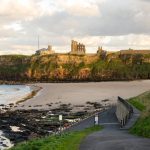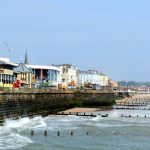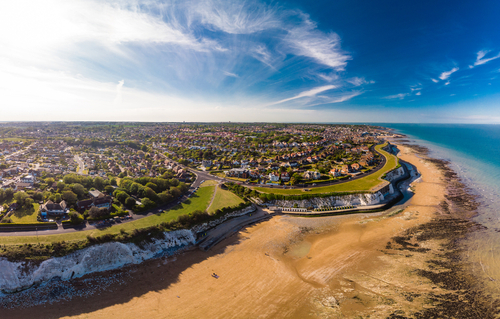
Margate is a town and seaside resort in north-east Kent on the south coast of England. Situated on Kent’s north coast, the town lies approximately 16 miles north-east of Canterbury and 4 miles north of Ramsgate. By the early 13th century the town’s port had gained important national status. And, by the early part of the 18th century, Margate had become one of the country’s first recognised holiday resorts.
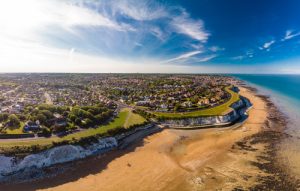
Image Credit: Martin Valigursky/Shutterstock.com
Margate A Fleeting History
Archaeological evidence has been found that suggests that the Margate area was inhabited as early as the Iron Age. The discovery of a Roman villa in Tivoli Park Avenue and other remains gives proof that the Romans were also present in Margate. During the 7th century Margate, along with the rest of the Isle of Thanet, fell under the jurisdiction of Minster Abbey. In 1050, though Margate was still little more than a fishing hamlet, St John’s Church was built. In 1124, the church was rebuilt by the Normans.
In 1229, Margate was adopted as a ‘limb port’ of Dover and became a member of the Confederation of Cinque Ports. The Confederation was made up of the five south coast settlements of Dover, Hastings, Hythe, New Romney and Sandwich. They were grouped together by Edward the Confessor in the 11th century for defence purposes. While membership gave Margate a boost in status, it also meant that the town now fell under the control of Dover. A situation that would last for more than 600 years.
By the mid-13th century, written records show the town was being referenced as ‘Meregeat’. The name is thought to be derived from the Old English words ‘mere’, meaning sea or lake, and ‘geat’, meaning gate, which refers to the local break in the cliffs. By the end of the century, the town was more commonly being referred to as ‘Margate’.
The Battle of Margate
On 24 March 1387 the little known ‘Battle of Margate’ (aka ‘Battle of Cadzand’) took place during the Caroline War, the second phase of the Hundred Years’ War. The battle took place between an English fleet and a Franco-Castilian-Flemish wine armada. However, Margate saw little action as the conflict was named simply by the fact that the 51 participating English ships had sailed from the town’s port. The battle actually took place off the coast of Cadzand in the Netherlands. Ending after 2 days, the English defeated the much larger but undermanned continental fleet. They also captured a number of enemy ships and confiscated a vast consignment of wine.
However, despite the port’s status, Margate very much continued its existence as a small fishing port for the next four centuries. There was a small amount of export from the town, which was mostly grain. Imports proved more popular, which mostly involved the smuggling of contraband goods from the continent.
The Georgian & Victorian Era
The story of Margate’s real development does not begin until the dawning of the Georgian Era in the early 18th century. With improving transport links, it was during the 1730s that Margate saw its first trickle of visitors seeking the pleasures of the seaside. In 1753, Benjamin Beale introduced his modified version of the bathing machine to Margate, which greatly helped to boost tourist numbers.
In 1815, significant development of the docks saw steamships using the harbour for the first time. By 1841, there were six separate steamship companies operating out of Margate. In April 1846, the South Eastern Railway (SER) opened its new line from Canterbury to Ramsgate. By December, the line was extended across Thanet to Margate. Greatly connectivity with London helped to generate ever-increasing visitor numbers to the town. In October 1863, the London Chatham and Dover Railway (LCDR) reached Margate from Herne Bay, improving connectivity even more.
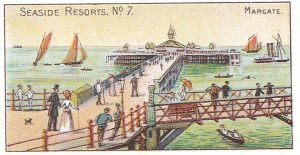
In 1887, a clock tower was built in the town to celebrate Queen Victoria’s Golden Jubilee. In the same year, a switchback railway (roller coaster) was built near Margate’s seafront. However, it was destroyed in the huge storm that hit the town in 1897. Nine of the town’s lifeboatmen were drowned in the storm. In 1899, a bronze statue of a lifeboatman was erected to commemorate the disaster. In 1901, an electric tram service started up, which linked Margate with Ramsgate and Broadstairs.
The War Years
In WW1, Margate suffered both shellings from the German navy and deadly silent aerial bombings from Zeppelins. In March 1916, the town witnessed the demise of the first Zeppelin on British soil. It was shot down over the coast by gunfire from Margate and crashed into the sea. In June 1914 as part of Britain’s defence of the South Coast, Royal Naval Air Station Westgate was opened at St Mildred’s Bay.
By late 1915 aircraft had begun using open farmland at Manston, 3 miles from Margate, as a site for emergency landings. By early 1916, the area was established as an Admiralty Aerodrome, which eventually was to become RAF Manston. Also in 1916, Margate was subject to some of the first attacks on Britain by fixed-wing aircraft. The bombings proved more deadly than previous attacks and saw 18 civilian deaths, 32 injured and property damage of some £31,000 (approximately £2 million in 2020). By 1917, improved air defences at Manston had brought an end to daylight enemy raids, though nighttime attacks continued for most of the rest of the war.
WWII Margate
In the interwar years, Margate continued to develop as a holiday resort. In 1920, the town’s amusement park that had opened in 1880 was refurbished and re-opened as ‘Dreamland’. Its design had been strongly influenced by the Coney Island theme park in Brooklyn, New York. Several cinemas, a swimming pool, a library and a new hospital, all opened in the town in the years leading up to the outbreak of World War Two.
During WW2, Margate was at the forefront of two of the conflict’s major events. Between May 26 and June 4 1940, some 850 private boats (‘the little ships’) set sail from Ramsgate as part of the allied WW2 Operation Dynamo. Around 48,000 men were brought back to Margate as part of the rescue from the beaches of Dunkirk. The second event was the ‘Battle of Britain’ which largely took place over the south coast of England between July and October 1940.
RAF Manston was a particular target during the conflict and was heavily bombed by the Luftwaffe, which resulted in many of its airfield buildings being destroyed. Margate itself also suffered from aerial bombing raids which saw a number of notable buildings being destroyed or severely damaged, including the Holy Trinity Church.
The Decline of The UK Seaside Holiday.
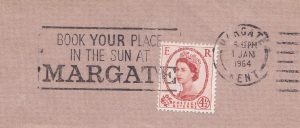
In 1967, a passenger ferry sailed out of Margate’s harbour for the last time. In the 1970s, the advent of the overseas package holiday combined with a downturn in the local industry saw Margate go into a long steady decline. In 1974, the town also lost its 117-year municipal borough status when government reorganisation saw it become part of the Thanet District of Kent. In the 1990s, a further downturn in the town saw Dreamland sell off some of its iconic rides to survive. In 2005, the company closed its doors for the last time and the site fell into disrepair.
Modern Era Margate
Today, Margate’s economy, much like the past, is still heavily dependant on retail and tourism. The last decade has seen a resurgence in its fortune as a tourist destination. While fishing in the town has been in decline for decades, it remains to be seen of it will make some kind of comeback under new nationwide government initiatives and investment for the industry.
One bright spot is its good commuter links which means an increasing number of London workers are calling Margate home. This has helped to sustain the local economy and probably aided by this the town now has a reputation as being a centre for the arts and culture. A number of studios and galleries have been established in the town in recent years, located in what is now known as the “Creative Quarter”. Consequently, many of the town’s new independent shops now have a slant towards the creative sector. The town’s recorded population at the 2011 National Census was 61,233 so it is not suffering too much.
Getting to Margate
By Road
From almost everywhere in the country, to get to Margate, it’s best to head to London first. There are excellent road links to Kent from London, via both the M20 and M2 motorways. From London, the shortest route to Margate is via the A2/M2/A29/A28.
By Bus
From almost all UK destinations it will be easiest to head to London first to complete any bus trip to Margate. There are around 80 coaches per day that make the 70 mile trip between London and Margate. The minimum journey time is about 2 hrs and the average around 2 hrs 30 mins. You can catch a coach from both London Victoria and Liverpool Street train stations.
By Train
There are around 140 trains per day between London and Margate, that leave from St Pancras (International), Charing Cross and London Victoria. The approximate 70-mile journey generally takes around 2 hours, although the fastest train takes about 1 hour 15 minutes.
By Air
The nearest airport to Margate is Southend Airport, 35 miles away, but it has a minimal flight schedule. The next nearest is London City Airport, about 60 miles away, which only has domestic and European flights. The nearest major international airport is London Gatwick, which is 70 miles away.
Notable People
A few notable people with connections to Margate are:
- Trevor Howard (1913 – 1988) – was an internationally renowned actor on stage and screen. His professional stage career began in 1934, with his prestigious film career kicking off a decade later. He is arguably best remembered for his starring roles in the films, ‘Brief Encounter’ (1945) and ‘The Third Man’ (1949). He was still making films right up to the time of his death in 1988. Trevor Wallace Howard-Smith was born in Cliftonville, Margate on 29 September 1913.
- Douglas Trendle (née Woods) – was born on 6 September 1958 in Stoke Newington, London. He was better known as Buster Bloodvessel, the frontman of the 1970S & 80s Ska band ‘Bad Manners’. Buster owned and ran the ‘Fatty Towers’ hotel in Margate for several years during the 1990s. It closed down in 1998 when Buster decided to move back to London.
- Tracey Emin – is a world-renowned contemporary artist who was born in Croydon, London in July 1963. She has produced work in a number of different mediums that include; drawing, painting, sculpture, film and photography. In 2011, she was appointed Professor of Drawing at the Royal Academy, the first female to be appointed to the position since the Academy was founded in 1768. Tracey grew up in Margate.
Did you know?
- In 1999, the British Film Institute voted ‘The Third Man’ as the ‘greatest’ British film of all time. One of the film’s stars was Margate born actor Trevor Howard.
- Douglas Trendle, who once lived in Margate, took his stage name ‘Buster Bloodvessel’ from that of the bus conductor in the 1967 Beatles’ film, ‘Magical Mystery Tour’.
- Britain’s first-ever amusement park opened on Margate’s seafront in 1880. It was later refurbished and re-opened as ‘Dreamland’.
- Discovered in 1835, no one knows why or when Margate’s famous underground ‘Shell Grotto’ was created (see below).
- “Margate” was the title of a UK single released by the jaunty cockney duo ‘Chas & Dave’ in 1982.
- The world-renowned 19th-century artist JMW Turner was a frequent visitor to Margate. Not least, because his love interest of the last 18 years of his life, Sophia Booth, was born and raised in the town.
- Margate is twinned with the towns of Yalta on the Crimean peninsular in Ukraine, Les Mureaux in France, and Idar Oberstein in Germany.
Sport In Margate
Margate FC
Margate FC currently plays their football in the Isthmian League Premier Division. Nicknamed ‘The Gate’ they play their home games at Handsdown Park, which currently has a capacity of around 2,100 which usually easily meets their needs. However back in 1972-3, there were 14,169 in the ground for the FA Cup Third Round Tie against Tottenham Hotspur.
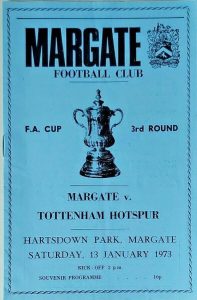
Margate FC’s finest 90 minutes
They are a historic little club, having been around since 1896 (in their 125th Year at the time of writing) and they are scheduled to play in the Isthmian League Premier in 2021. If you are a football fan and are planning to be in town during the season then do take in a game. Smaller clubs are always grateful for a bit of extra support. You can check out their website for fixture updates here.
Thanet Wanderers RUFC
Thanet Wanderers RUFC is based about 2 miles out of Margate at Broadstairs. The first XV currently play in London and South East Division 2. They play home games at St Peter’s Recreation Ground.
Things to do in Margate
Here are a few things worth checking out when next you are in town:
- The Escapement – is a themed escape-room adventure. You have 60 minutes to escape from the room by solving a series of riddles and clues. There’s a choice of two escape adventures, either from an Egyptian Tomb or a mutinous Pirate Ship. A great way for a family or a group of friends to spend a couple of hours.
- Margate Main Sands – is a centrally-located popular sandy beach. A short stroll from the beach is the traditional seaside arcades, amusements and children’s rides, with plenty of places to eat and drink. There’s seasonal lifeguard cover between May and September.
- Rib Request Boat Trips – offer a full range of boat trips around the coast that vary from a 15-minute lively powerboat experience to a full day’s leisurely excursion. There’s also seal and wildlife trips, wind farm trips, and bay & beach trips.
- The Viking Coastal Trail – is a mostly traffic-free, gently rolling 25-mile cycling and walking trail, that loops around the District of Thanet. You can make your own itinerary as there are no official guides or organised groups.
- Botany Bay – while Sydney’s infamous ‘Botany Bay’ is more than 10,000 miles from Margate, this particular one happens to be only 2 miles away. It sits at the foot of chalk cliffs where there’s a wide, clean, sandy beach with plenty of rock pools – making it ideal for kids! Local facilities include toilets, a lost-child centre, a café and plenty of parking.
Things to see in Margate
Some of the things definitely worth seeing in the town are:
- Spitfire and Hurricane Memorial Museum – is situated about 3 miles inland from town at the former World War 2 RAF Manston base. The aviation museum’s main attractions are a perfectly restored Spitfire and Hurricane from the Second World War. However, there’s also plenty of wartime artefacts and memorabilia as well as a café.
- Turner Contemporary – is a free-to-enter art gallery that runs a timetable of constantly changing exhibitions. There’s also a special room for kids which features toys, games and activities. Their Public Learning Programme regularly hosts workshops, projects, talks, film screenings, and live performances of various art forms.
- The Shell Grotto – is an ornate subterranean passageway about 70 ft (21 m) long and 8 ft (2.4 m) high. The walls and roof’s surface are entirely covered in mosaics created by an estimated 4.6 million seashells. Discovered in 1835, its age and purpose, remain unknown to date. This must-see totally unique entity has a Grade I-listed status.
- Hornby Visitor Centre – displays some of Britain’s most iconic and best-loved toys from the last 80 years. It also features rare products from the likes of Hornby, Scalextric, Airfix and Corgi. There’s also an opportunity to get hands-on with model railways and Scalextric model racing track. It’s a great day out for the whole family.
- Wingham Wildlife Park – a few minutes drive out of Margate is one of Kent’s most popular attractions. Amongst others, the park houses big cats, otters, wolves, lemurs, monkeys, crocodiles and penguins. There are also daily talks and feeding sessions where visitors can get up close and personal with their favourite animals.
Where to stay?
Inns and small hotels form the majority of the readily available type of accommodation in Margate at the lower end of the market. Higher priced accommodation, usually large hotels, obviously bring more luxury. Family rooms and apartments are also readily available, which generally offer value for money if you are travelling in a group. At only 2 miles and 4 miles away respectfully, Broadstairs and Ramsgate offer practical alternatives to staying in Margate, although prices are similar. A broad price guide for an overnight stay in the town for 2 adults sharing is:
Inn/B & B/Guesthouse/Lodge/Hotel: £60 – £100
Luxury Hotel: £100 – £200
Thinking of moving?
Are you thinking of moving to Margate? Over the last 12 months, properties in Margate have fetched an overall average price of £240,300. In the last year, the town’s best-selling properties have been terraced houses, which have sold for an average price of £227,600. Flats sold for an average of £135,400, semi-detached properties for £290,000, with detached properties fetching £360,300. The average property in Margate has in the last 12 months sold for 5% more than in the previous year.
Thanks for joining us on our quick tour of Margate a histories seaside resort which makes a great base to explore the scenic Kent coast. Before you go why not try some of our other quizzes or have a look at some of our other location guides. better still why not join our growing community it’s free and could be very rewarding going forward.


